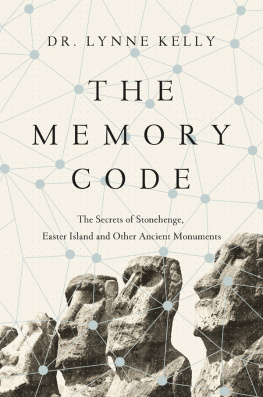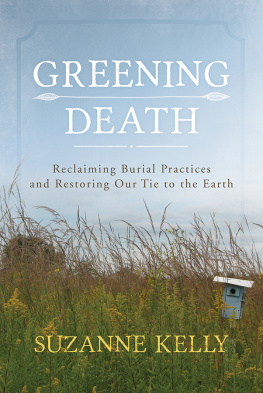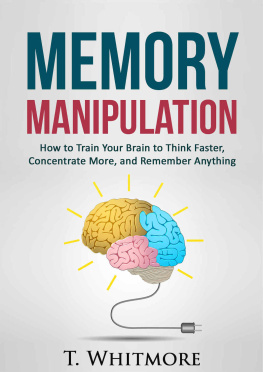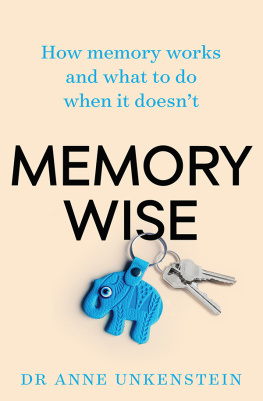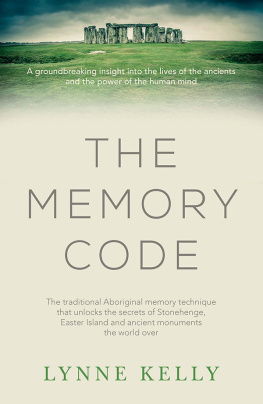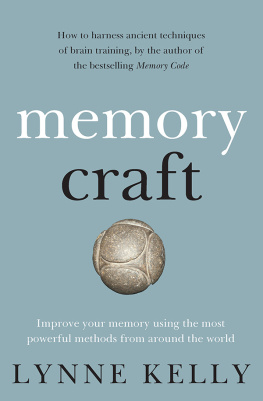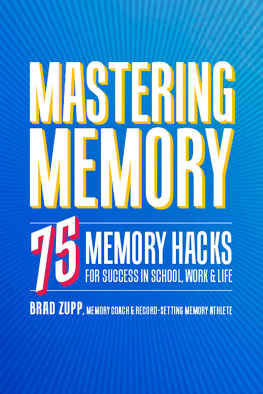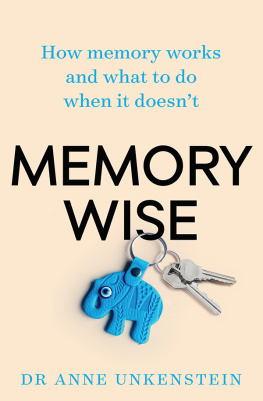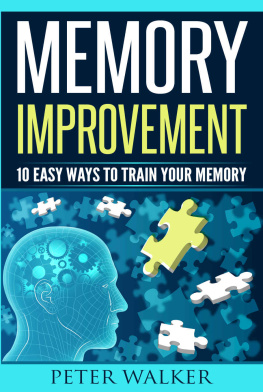Kelly - The Memory Code 2
Here you can read online Kelly - The Memory Code 2 full text of the book (entire story) in english for free. Download pdf and epub, get meaning, cover and reviews about this ebook. City: New York, year: 2017, publisher: Pegasus Books, genre: Religion. Description of the work, (preface) as well as reviews are available. Best literature library LitArk.com created for fans of good reading and offers a wide selection of genres:
Romance novel
Science fiction
Adventure
Detective
Science
History
Home and family
Prose
Art
Politics
Computer
Non-fiction
Religion
Business
Children
Humor
Choose a favorite category and find really read worthwhile books. Enjoy immersion in the world of imagination, feel the emotions of the characters or learn something new for yourself, make an fascinating discovery.
The Memory Code 2: summary, description and annotation
We offer to read an annotation, description, summary or preface (depends on what the author of the book "The Memory Code 2" wrote himself). If you haven't found the necessary information about the book — write in the comments, we will try to find it.
Kelly: author's other books
Who wrote The Memory Code 2? Find out the surname, the name of the author of the book and a list of all author's works by series.
The Memory Code 2 — read online for free the complete book (whole text) full work
Below is the text of the book, divided by pages. System saving the place of the last page read, allows you to conveniently read the book "The Memory Code 2" online for free, without having to search again every time where you left off. Put a bookmark, and you can go to the page where you finished reading at any time.
Font size:
Interval:
Bookmark:

THE
MEMORY
CODE
The Secrets of Stonehenge, Easter Island,
and Other Ancient Monuments
DR. LYNNE KELLY

THE MEMORY CODE
Pegasus Books Ltd
148 West 37th Street, 13th Floor
New York, NY 10018
Copyright 2017 by Lynne Kelly
First Pegasus Books hardcover edition February 2017
All rights reserved. No part of this book may be reproduced in whole or in part without written permission from the publisher, except by reviewers who may quote brief excerpts in connection with a review in a newspaper, magazine, or electronic publication; nor may any part of this book be reproduced, stored in a retrieval system, or transmitted in any form or by any means electronic, mechanical, photocopying, recording, or other, without written permission from the publisher.
ISBN: 978-1-68177-325-4
ISBN: 978-1-68177-382-7 (e-book)
Distributed by W. W. Norton & Company, Inc.
For Damian Kelly,
Leah, Abigail and Rebecca Heitbaum
CONTENTS

Other books by Lynne Kelly
Knowledge and Power in Prehistoric Societies
Spiders: Learning to love them
Crocodile: Evolutions greatest survivor
The Skeptics Guide to the Paranormal
Co-authored
Exploring Chaos and Fractals

I had no idea that indigenous animal stories from around the world would lead me to a new theory for Stonehenge. I had a PhD scholarship as a science writer and was looking forward to three years of gentle research leading to a natural history book about animal behaviour and indigenous stories. Eight tumultuous years later and that book is now in your hands, bearing only scant resemblance to the confident outline that started my journey.
It was only weeks into the PhD in the English program at La Trobe University that I glimpsed the complexity of Australian Aboriginal elders knowledge, the first group of cultures I explored in depth. They memorised a vast amount of information about animals, their identification and behaviour, habitats and uses. A huge number of species of birds, mammals, reptiles and invertebrates were accurately described in stories, even when they had no apparent practical use. I realised that the elders could identify all the animals across a wide landscape, when I was struggling with just the birds in my local area. I had a field guide; they had only memory.
I started asking the question which soon became an obsession: how could they remember so much stuff?
At our second meeting, my PhD supervisor, Professor Sue Martin, named a list of suggested resources, casually adding and it might be worth looking at Ong on morality. I dutifully wrote down Ong and morality, wondering if it was something about my ethics that was giving her concern. I found Ongs book in the library. The title was Orality and Literacy.
Orality, I soon discovered, was about making knowledge memorable. It was about using song, story, dance and mythology to help retain vast stores of factual information when the culture had no recourse to writing. It was the first step to understanding how they could remember so much stuff. The definition of stuff was growing rapidly to include not only the animal knowledge I was researching, but also the names and uses of plants; resource access and land management; laws and ethics; geology and astronomy; genealogies, to ensure they knew their rights and relatives; navigation, to ensure they could travel long distances when there were no roads or maps; ideas about where they had come from; and, of course, what they believed. Indigenous cultures memorised everything on which their survivalphysically and culturallydepended.
I wasnt far into my research when I began to understand that songlines were key to the way Indigenous Australians organised this vast store of information so that it would not be forgotten. Songlines are sung narratives of the landscape, singing tracks that weave across the country and enable every significant place to be known. At each location, rituals are performed that enact the knowledge associated with that specific place. In this context, rituals are repeated acts and no more should be implied by that word. The degree to which they are religious ceremonies depends entirely on the specific ritual. One elder explained to me how singing the names of the sacred sites along the songlines created a set of subheadings to the entire knowledge base, a place for knowing about every animal, plant and person. The songlines could be sung when moving through the space in reality or in imagination.
By repeating the stories of the mythological beings through songs and dances at sacred landscape sites, information could be memorised, even if it was not used for tens, hundreds or thousands of years. Songs are far more memorable than prose. Dances can depict animal behaviour and tactics for the hunt in a way no words can do. Mythological characters can act out a vivid set of stories that are unforgettable.
I recognised that Aboriginal elders were using their songlines in a similar way to the ancient Greek orators who mentally walked through their buildings and streetscapes from location to location to help them memorise their speeches. They called it the method of loci. Modern memory champions memorise shuffled decks of cards using the same method, walking through their homes or churches, grand buildings or public spaces in their imaginations as they recall each card. They call them memory palaces.
A few months later, I travelled to England with my husband, Damian. He had also returned to university, in his case to study archaeology. My goal was to spend time at museums looking for representations of animals among indigenous collections to frame my book. Damian was off to visit archaeological sites. The downpour on the day hed planned to go to Stonehenge was so intense that he decided not to stop on his journey to Cornwall. On a fine day, he wanted to try again. I just wanted to get to Bath and indulge in Jane Austen. Dutifully, I walked around Stonehenge, tourist earphones providing commentary. At that early stage of my newly acquired obsession, I was so immersed in my subject that I naively expected orality and memory to be the focus of every commentary. The disembodied voice with the perfect English accent told me about the various theories but didnt mention orality or memory or anything about the builders system of knowledge. There was a great deal of very important information, but I was immune to it, listening only for my pet topic.
Stonehenge was initially a simple stone circle built at the very start of the transition from a mobile hunting and gathering lifestyle to settling and farming. What would happen, I asked myself on Salisbury Plain that day, to the knowledge that these people had acquired over thousands of years and embedded in the landscape? Farming doesnt happen rapidly. The transition takes time. How would the settlers avoid forgetting all their songs and stories and knowledge of the animals and plants if they were no longer visiting the memory locations their ancestors had spread across the broad countryside? How clever of them, I decided. Theyve replicated a series of landscape sacred places in their local environment. What could be more perfect than a circle of stones, each stone representing a former sacred location, each stone acting as a memory aid? I didnt realise that this had never been suggested before.
Next pageFont size:
Interval:
Bookmark:
Similar books «The Memory Code 2»
Look at similar books to The Memory Code 2. We have selected literature similar in name and meaning in the hope of providing readers with more options to find new, interesting, not yet read works.
Discussion, reviews of the book The Memory Code 2 and just readers' own opinions. Leave your comments, write what you think about the work, its meaning or the main characters. Specify what exactly you liked and what you didn't like, and why you think so.

